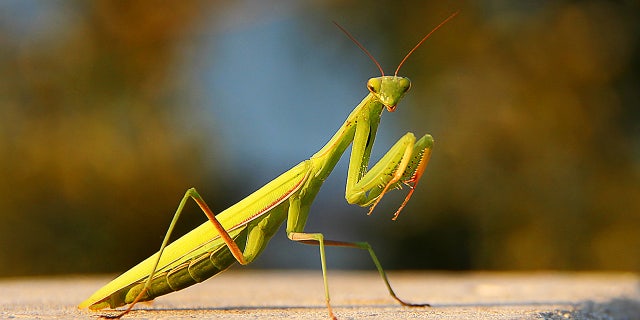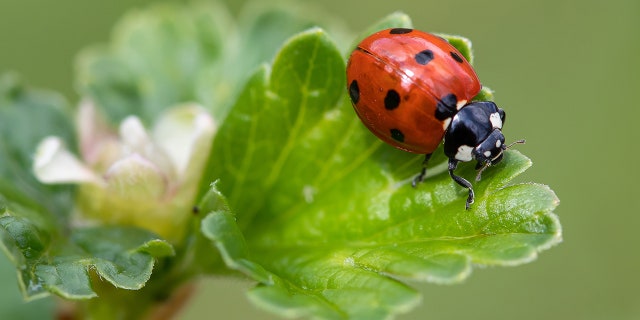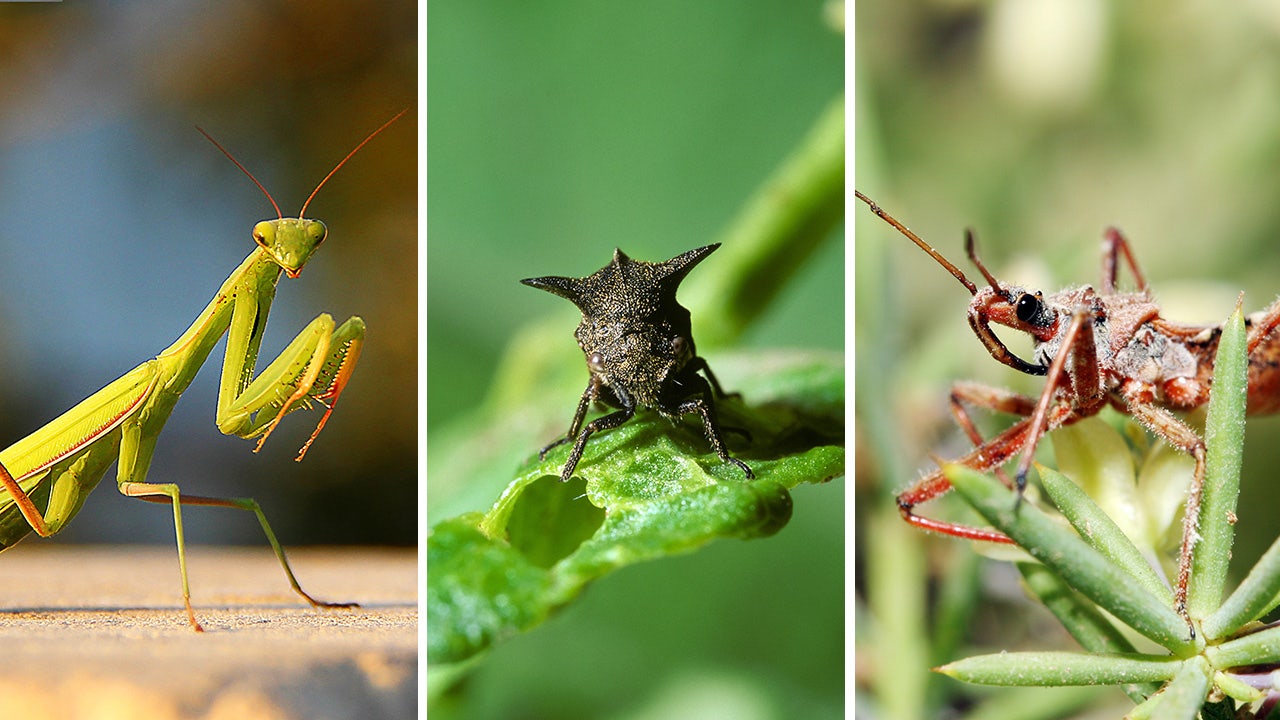Odd bugs: Fascinating facts about praying mantises, walking sticks and other unique-looking insects
Spring has sprung!
That means the bugs and insects have come out to play.
Now is your chance to test your knowledge about some interesting facts about common spring bugs and learn about some of the most bizarre insects found in America.
GOOD LUCK OMENS! WHY THE PRAYING MANTIS, BUTTERFLY AND LADYBUG ARE THOUGHT TO BRING GOOD THINGS
You may even find some of these odd insects in your garden this spring.
Read on for more details …

A praying mantis (left), a horned treehopper (middle) and a species of an assassin bug (right) are photographed. Read on for fascinating and numerical facts on these bugs and others. (iStock)
1. How many horns do horned treehoppers have?
The horned treehopper, scientifically labeled centrotus cornutum, can have one to three horns that help this insect blend into its surroundings.
Treehoppers with three horns are called tri-horned treehoppers.
They are exclusively native to Australia.

Horned treehoppers are exclusively native to Australia. (Patrick LORNE/Gamma-Rapho via Getty Images)
Horned treehoppers have the horned helmets to help “the treehoppers avoid predation through camouflage or intimidation,” according to Nature Journal.
2. How many legs does a monkey slug caterpillar have?
This fuzzy-looking spider will one day transform into a hag moth.
The monkey slug caterpillar has six fuzzy arms, according to IFL Science.
The monkey slug’s tentacle-like arms extend and reach out as it crawls, “giving the appearance of a terrestrial octopus,” according to Insectidentification.org, a database of insects, bugs and spiders.
“Though other hairy caterpillars have a reputation for prickly defenses, this caterpillar does not sting,” the website states.
“Quite often, the caterpillars of this family attract more interest than the adult moths.”
These ugly-duckling bugs can be found as northbound as Maine and as southbound as Florida, extending westward to Nebraska, Arkansas and Mississippi, according to treehugger.com, a sustainability website.
3. How many eggs can a praying mantis lay at a time?
The praying mantis is one of the most identifiable insects found in the spring because of its recognizable stance that resembles hands in a prayerful position.

If found in or around your home, a praying mantis is thought to represent an angel that is watching over you, Fox News Digital previously reported. (iStock)
Praying mantises can lay up to 400 eggs at a time, “which are deposited in a frothy mass that is produced by glands in [the female’s] abdomen,” Boreal Science reported.
There many unique-looking insects in the mantis family, from the orchid mantis to the devil’s flower mantis.
Yet the most common types mantis found in North America are the Carolina mantis, European mantis and the Chinese mantis, said the National Pest Management Association in Virginia.

A praying mantis on a leaf in New York’s lower Hudson Valley, July 2022. (Fox News Digital)
4. In what year was the man-faced stink bug first discovered?
The Man-Faced Stink Bug was first discovered in 1778 by British entomologist Dru Drury, Scientific American stated.
While stink bugs are a common spring pest in the U.S., this specific face-patterned insect is only native to Southeast Asia and India.
5. What is the average lifespan of a walking stick in the wild?
It is common for insects to only live a certain amount of weeks or months.
However, the walking stick can live upwards of three years, said National Geographic Kids.
🚨Invasive species alert! While admiring a funky succulent, I almost didn’t notice this Indian walking stick! Native to southern India, these bugs have been shipped around the world & marketed as an easy, low-effort pet for kids. This one is likely a descendant of an escapee. pic.twitter.com/wVFQtzzOlm
— Smithsonian NMNH (@NMNH) September 1, 2021
“Newly hatched walking sticks reach adult size once they’ve undergone several molts [and] they reach maturity between three months and one year,” according to the National Wildlife Federation.
ORANGE LADYBUGS AND THE SPIRITUAL MEANING BEHIND THE INSECT: WHAT TO KNOW
6. What do the seven spots on a ladybug mean?
The spots found on the back of a ladybug serve as a defense mechanism to ward off any predators, according to National Geographic Kids.

Ladybugs are often considered a spiritual symbol or a good luck omen. (iStock)
The seven spots of the ladybug, the lady symbolizing the Virgin Mary, are said to have represented “Mary’s seven joys and seven sorrows,” the University of Wisconsin Milwaukee stated.
7. How many bees does it take to weigh one pound?
One bee weighs .00025 pounds, according to Big Island Bees, an organic honey supplier located in Hawaii.
It would take 4,000 bees to exactly one pound exactly, the brand continued.
That single .00025 pound bee will produce one tablespoon of honey in its lifetime.
CLICK HERE TO SIGN UP FOR OUR LIFESTYLE NEWSLETTER
8. How long does it take an assassin bug to kill its prey?
Native to Texas, New Mexico, Arizona and other southern states, the assassin bug has a beak that will retract and inject its prey with poison.
Within 30 seconds, the insect’s prey will die form the toxins injected into its system, Growing Small Farms from North Carolina State University wrote.

“There are nearly 200 species of assassin bugs found in North America, including the wheel bug, the kissing bug and ambush bugs,” according to the National Pest Management Association, headquartered in Virginia. “While these insects can be beneficial in the garden as a form of natural pest control, they inflict painful, venomous bites if provoked and some can even spread disease.” (iStock)
If you are bitten by an assassin bug, wash the bite and apply antiseptic, the National Pest Management Association advised.
CLICK HERE TO GET THE FOX NEWS APP
Contact a medical professional if you notice changes to the bite area or if you start showing signs of a life-threatening allergic reaction “such as swelling, itching, hives or difficulty breathing,” the site stated.




